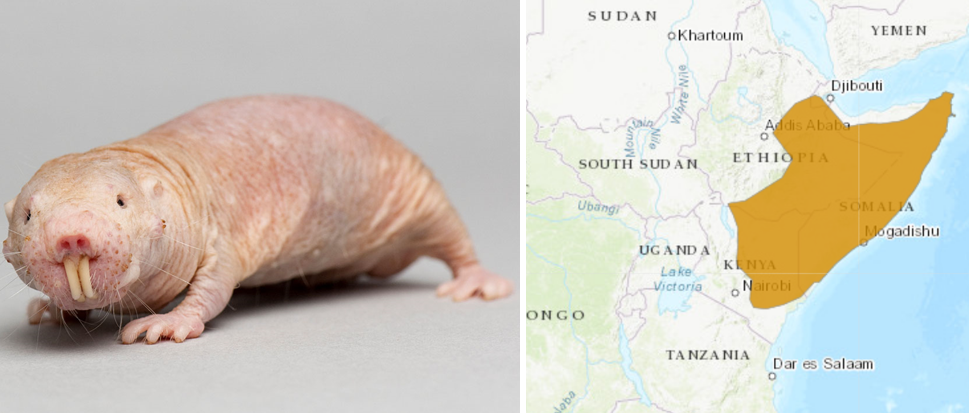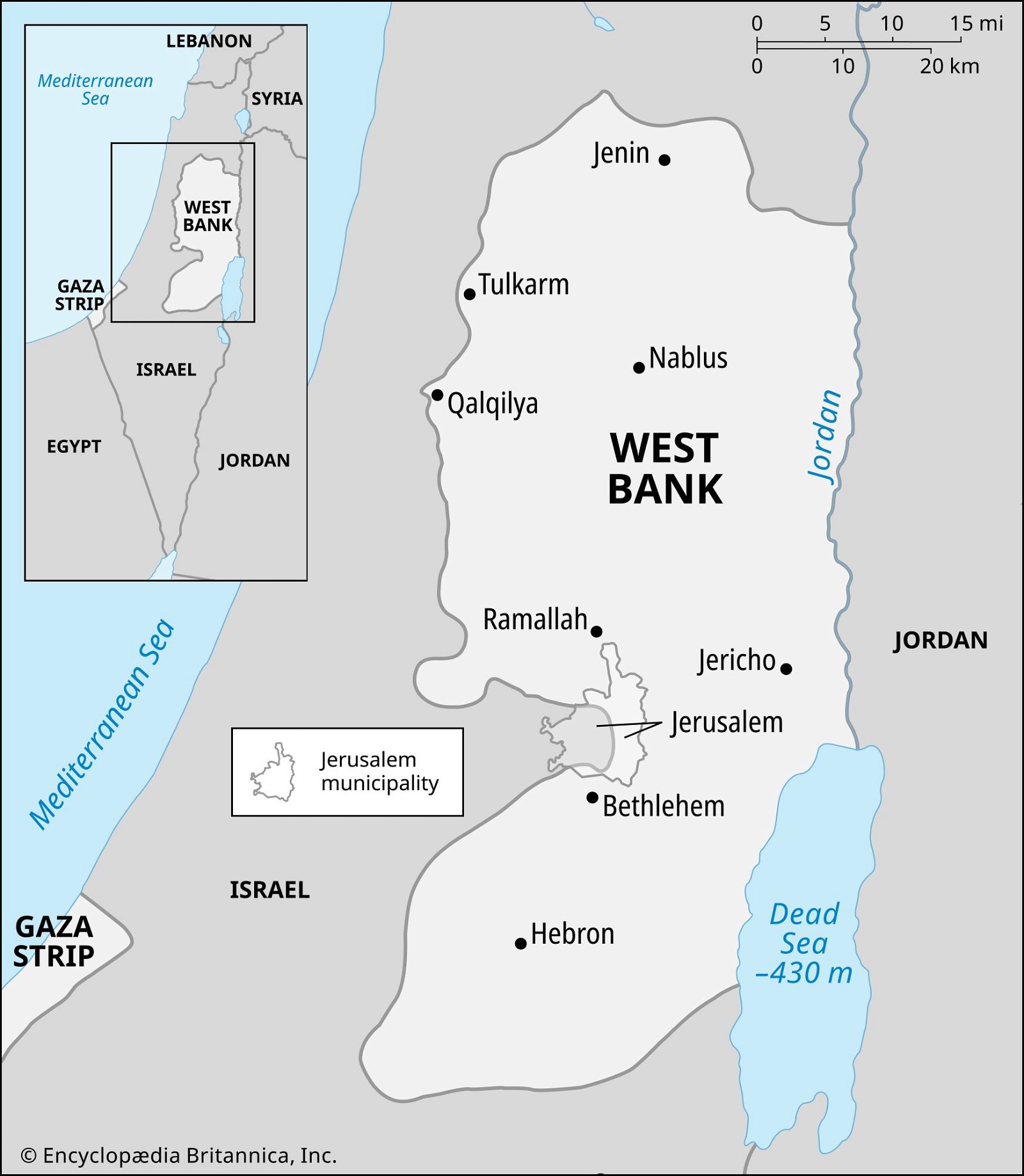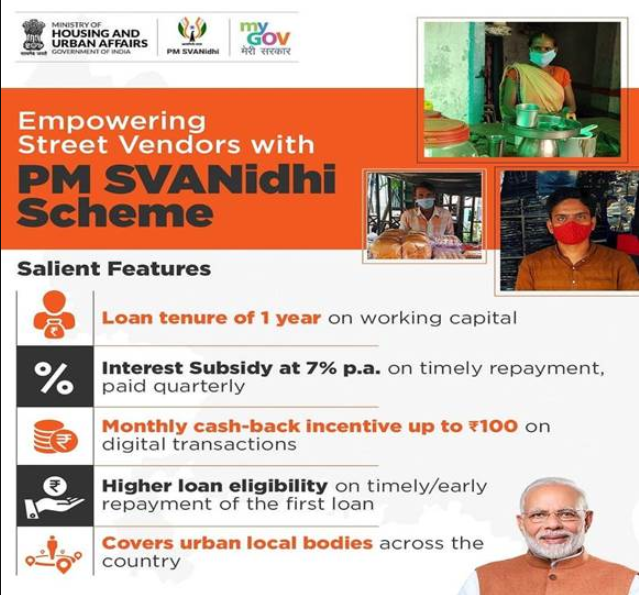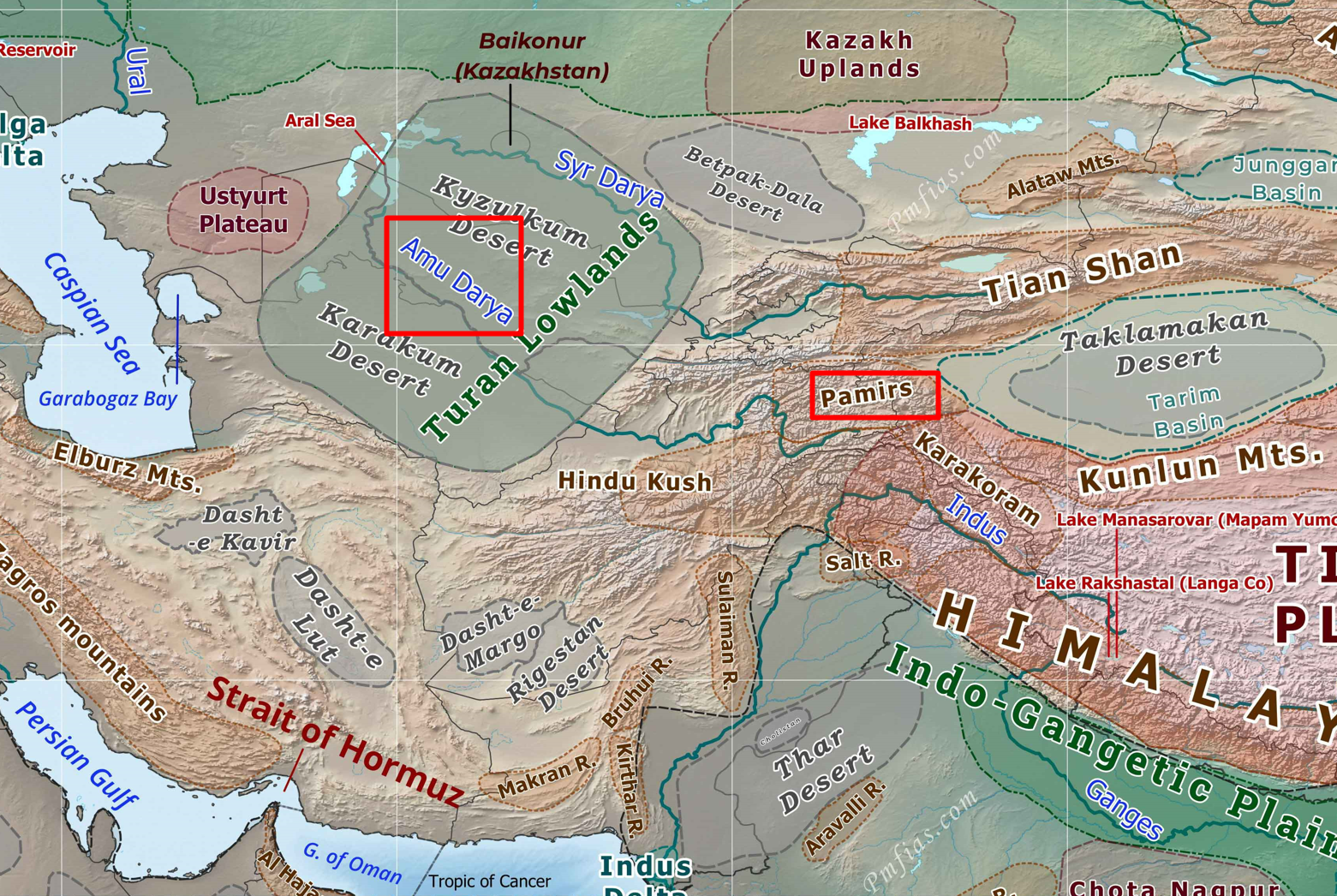
Current Affairs for UPSC Civil Services Exam – March 25-26, 2024
Subscribers of "Current Affairs" course can Download Daily Current Affairs in PDF/DOC
Subscribe to Never Miss an Important Update! Assured Discounts on New Products!
Must Join PMF IAS Telegram Channel & PMF IAS History Telegram Channel
{GS1 – A&C – Laws} Delisting of ASI monuments
- Context (IE): The Archaeological Survey of India (ASI) has released a list of 18 centrally protected monuments that it wants to delist.
Monument of National Importance
- Monuments that are considered of significant historical importance, as mandated by the Ancient Monuments and Archaeological Sites and Remains Rules 1959 (AMASR Act).
- They are designated by the Archaeological Survey of India (ASI).
- It authorises the central government to “maintain, protect and promote the site”.
- Any construction-related activity is not allowed around the protected site.
- Currently, 3,693 monuments of national importance are being protected by the ASI.
Delisting Process
- Section 35 of AMASR Act 1959: To delist the monuments, stating that these “have ceased to be of national importance”.
- Central Government issues notification in this regard, inviting “objections or suggestions” from the public within two months.
- ASI no longer remains responsible for delisted monuments.
Current move
- Parliamentary report by ASI: In a report titled ‘Issues relating to Untraceable Monuments and Protection of Monuments in India, ’ the Ministry of Culture told Parliament that 50 of India’s 3,693 centrally protected monuments have gone missing.
- Comptroller and Auditor General (CAG) 2013 report: It declared 92 monuments as “missing” after a first-of-its-kind physical verification exercise undertaken after Independence.
- Rapid urbanisation and submergence by reservoirs or dams are major reasons for disappearance.
- Rationalisation of the list: Parliamentary panel observed that the list of ASI-protected sites includes a large number of “minor monuments” and recommended that it be “rationalised and categorised.”
- Finalisation of 18 monuments: List Includes monuments from Uttar Pradesh (11), Delhi (2), Haryana (2), and others in Assam, West Bengal, Arunachal Pradesh, and Uttarakhand.
{GS1 – IS – Population} Declining Fertility Rate
- Context (IE): According to the Lancet study, India’s total fertility rate (TFR), the average number of children born per woman, is dipping irreversibly to 1.29, far lower than the replacement rate of 2.1.
- The study was based on the Global Burden of Diseases, Injuries, and Risk Factors Study 2021, a research effort led by the Institute for Health Metrics and Evaluation at University of Washington.
Global Fertility Rate Trends
- During the period from 1950 to 2021, global TFR more than halved, from around five children for each woman in 1950 to 2.2 children in 2021.
- Future fertility rates were projected to continue to decline worldwide, reaching a global TFR of 1·83 in 2050 and 1·59 in 2100.
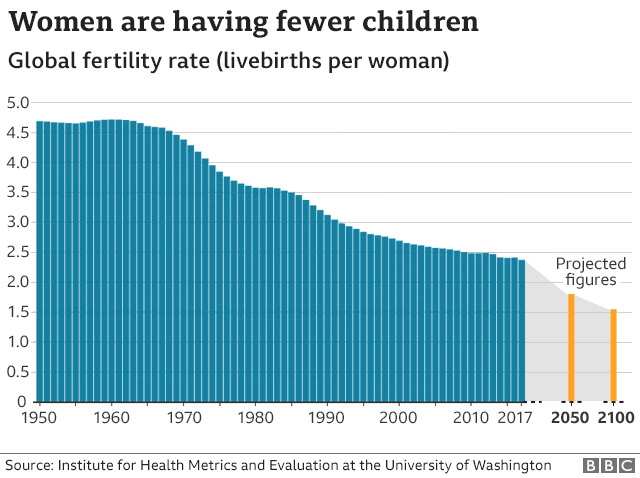
- The two nations projected to have the lowest predicted fertility rates in 2050 are Puerto Rico (0.84) and South Korea (0.82).
- The distribution of live births worldwide is shifting, with a greater proportion occurring in the lowest-income countries.
- In 1950, one-third of the global live births occurred in Southeast Asia, East Asia, and Oceania.
- However, this concentration has shifted to the sub-Saharan African region, which, after 2011, accounted for the largest share of live births — increasing from 8 percent in 1950 to nearly 30 percent by 2021.
- Change in the distribution of live births will result in a “demographically divided world” where high-income nations will have to deal with the effects of an ageing population and a shrinking workforce, while low-income areas will struggle with high birth rates and resource constraints.
- The proportion of live births in low-income areas worldwide will almost quadruple from 18% in 2021 to 35% in 2100.
- By 2100, one out of every two children born will be born in sub-Saharan Africa alone.
- The GBD report says that by 2050, fertility rates in three-quarters of all countries will not be high enough to support population growth.
- In India, the TFR was 6.18 in 1950, which reduced to 4.60 in 1980 and further declined to 1.91 in 2021.
- China is already dealing with the demographic disadvantage of an ageing population. India, too, is heading in that direction. These two nations together account for more than a third of the world’s population.
Reasons for declining fertility rate
Decline in Infant mortality
- Various maternal and child health-related programmes, like the Family Welfare Programme, including maternal and child health-related cash transfer inducements and successful immunisation in India, guaranteed child survival, giving rise to small families.
Economic dimension
- With development, the inter-generational flow of wealth has reversed. “This means parents now do not receive as much benefit from their children as they used to.
- This has influenced the decision to have an additional child, which would involve a substantial cost of raising them.
Women empowerment
- The rise of female literacy and women’s participation in the workforce. Career consciousness, financial returns, and economic independence have meant that women are reconsidering their options for having a second child.
- In the urban space, many women do not consider child-rearing as a must-do task; they are instead choosing not to have babies at all and even considering options like adoption. This pattern is percolating in rural India, too.
Long-term consequences of declining fertility rates
- Low levels of fertility have the potential over time to result in inverted population pyramids with growing numbers of older people and declining working-age populations.
- Sustained low fertility rates might likewise lead to labour shortages in some sectors, potentially hindering economic growth.
- Reliance on immigrants will become increasingly necessary to sustain economic growth in low-fertility countries.
- Continued skilled worker migration to high-income, low-fertility economies—a concept referred to as brain drain—can also have devastating effects on the economies these workers leave behind.
- Increase the burden on health care and social systems, transform labour and consumer markets, and alter patterns of resource use.
{GS2 – IR – India-Pak} India-Pakistan bilateral trade
- Context (IE): Pakistan may ‘seriously examine’ resuming trade with India.
Halting of trade
- Article 370 abrogation: Bilateral trade between India and Pakistan has been halted since 2019.
- 200 per cent tariff: India revoked Pakistan’s Most Favoured Nation (MFN) status” post-Pulwama attack and imposed high tariffs on Pakistani imports.
Composition of trade before suspension
- Restriction despite MFN since 1996: Pakistan allowed only 138 products to be imported with a negative list of 1209 products.
- Trade surplus from India: Total value of goods and services it exported to Pakistan was much larger.
- Very little share in India’s trade: India-Pakistan trade was $2.29 Bn (0.35% of India’s overall trade).
- Imports from India: Cotton, organic chemicals, plastics, tanning/dyeing extracts, nuclear reactors, boilers, machinery, and mechanical appliances.
- Imports from Pakistan: Mineral fuels and oils, edible fruits and nuts, salt, sulphur, stone and plastering materials, ores, slag and ash, raw hides, and leather.
Demand to resume trade
- Circumvention of trade: Imports to Pakistan are continued through Dubai or Singapore, resulting in extra freight, transhipment, transportation costs, etc.”
- Multiple crises: Devastating floods in 2022, high inflation, political instability, and structural issues led to a food and energy crunch in Pakistan.
- Central Asian trade: Indian traders hope to improve access through Attari integrated check post.
{GS2 – Polity – IC – Elections} Vote from Home Facility in LS Elections
- Context (TH): For the first time in the history of the Lok Sabha elections, the Election Commission of India (ECI) extended its ‘vote-from-home’ facility to Persons with Disabilities (PwD) and senior citizens aged 85 and above.
- The VfH facility was previously tried out during Assembly elections in select regions, allowing PwD, senior citizens and people affected by COVID-19 to vote from home.
- The ECI has, however, increased the upper age limit for elderly voters from 80 to 85 years.
Who is eligible to avail the vote-from-home facility?
- People aged 85 and above.
- Persons with Disabilities: The disability shall not be less than 40% of the prescribed handicap and certified by the certifying authority.
- Media persons covering ‘polling day activities’.
- Workers from essential services: Services such as metros, railways and health care.
- Service voters: Armed forces personnel posted away from their hometowns, Central Armed Police Forces personnel deployed away from home, and those on poll duty.
How to avail the vote-from-home facility?
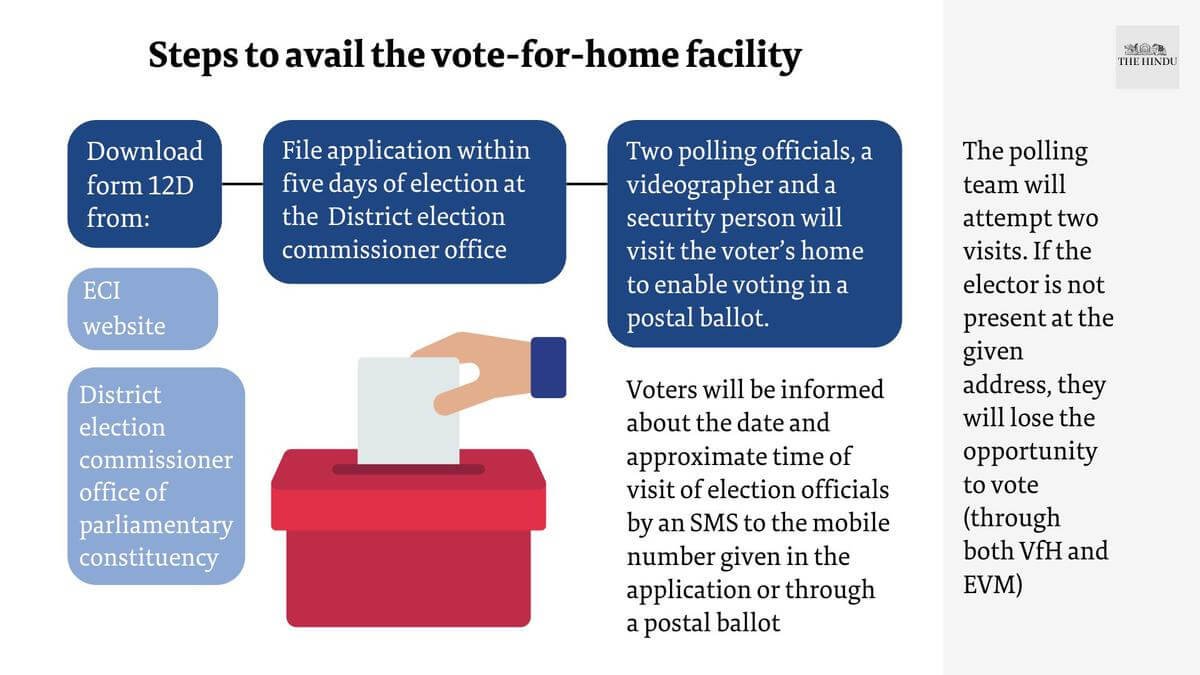
- During the visit, the polling team is expected to follow protocol under the Conduct of Elections Rules, 1961.
- Each team of poll officers is required to:
- Issue postal ballot to each of the Absentee Voters assigned to it,
- Brief the elector about the procedure to be followed for voting through postal ballot,
- Make sure that the elector votes without anyone influencing his/her choice, and ensuring the secrecy of voting, all activities at the address of the elector concerned, according to a November 2022 communique for the Vote-from-home facility.
Other Steps taken by ECI for Inclusive Elections
- The government is also experimenting with remote voting for domestic migrants.
- The Multi Constituency Remote Electronic Voting Machine (RVM) would allow people who migrate within the country for employment and opportunity (almost 450 million, as per the latest 2011 census) to vote for their home constituencies from remote locations.
- If a senior citizen or a person with disability chooses to go to the booth, the ECI has mandated officials to provide Assured Minimum Facilities (AMF) like ramps, wheelchairs, first aid and toilets at polling stations.
{GS2 – Social Sector – Health – Diseases} Elimination of Tuberculosis
- Context (TH | TH | TH | TH): On March 24, World TB Day was celebrated, marking Dr. Robert Koch’s discovery of the TB-causing bacteria in 1882.
- The theme for World TB Day 2024 is Yes! We can end TB.
Challenges in TB Control in India
- Despite discoveries of treatments like streptomycin in 1943 and antibiotics in the 1950s and 1960s, TB remains a significant challenge, and there are many obstacles to overcome in fighting it.
- Despite efforts, different forms of TB, like drug-resistant TB (DR-TB), continue to challenge control efforts.
- Molecular testing is the best but is not available to many patients.
- TB survivors often face stigma, discrimination, and mental stress, along with treatment side effects.
- TB affects people from all backgrounds but hits marginalized groups like children, urban poor, prisoners, and those with HIV/AIDS the hardest.
- Diagnosing tuberculosis (TB) remains a major challenge globally, according to experts.
Related Facts
|
Suggestions to Improve Diagnosis
- To tackle TB, we need to improve diagnosis methods. This involves using existing systems better and adopting new technologies for quicker and more accessible diagnosis.
Need to utilise X-ray imaging during the screening procedures
- For example, India conducts active case-finding efforts nationwide. However, recent studies suggest that symptom-based screening alone may miss many TB cases, as some infected individuals show no symptoms but can still spread the disease.
- So, there is a need to utilise X-ray imaging that can quickly and efficiently find TB patients.
- X-ray imaging has improved significantly, with portable devices and AI-driven software that can quickly detect possible TB cases.
- New technologies like the urine LAM test offer rapid screening for both lung and extra-lung TB cases, aiding in effective population screening.
Need to use Molecular tests to confirm TB bacteria presence
- Molecular tests are faster and more precise than the traditional sputum microscopy test.
- India has increased its molecular diagnostic capacity, but these tests are costly and not easily accessible.
- The NAAT (nucleic acid amplification test) machines in India have gone up from 651 in 2017 to more than 5,000 in 2022.
- Challenges: Molecular testing is reliant on sputum collection and testing. Collecting sputum samples poses challenges, especially for children, and transporting samples in remote areas is difficult.
Need to explore other collection techniques
- During the COVID-19 pandemic, simpler testing methods like nasal swabs and saliva samples increased testing coverage.
- We should consider using tongue swabs for TB sample collection, which is simple and cost-effective.
- PCR machines, proven useful during COVID-19, can also be utilised for TB diagnosis across the country.
10-Point Agenda to Control TB in India
- Early Detection and Screening: Early detection is crucial for TB, as symptoms are often ignored. Screening of family and contacts of infected individuals is vital, requiring accessible lab facilities and efficient follow-up systems.
- Precise Treatment Categorization: This is essential due to the increasing number of drug-resistant TB cases. Knowing resistance status at diagnosis helps assign appropriate treatment.
- Treatment Adherence and Monitoring: TB treatment requires a long duration, so non-compliance can occur due to various reasons, like health improvement or relocation. It is important to use technology to monitor compliance.
- Preventing TB-related deaths: whether from drug-resistant or non-pulmonary TB, is critical.
- Controlling Drug Resistance: This is crucial as it’s often caused by the misuse of antibiotics and non-compliance with treatment. Poor regulation of drug use and treatment non-compliance contribute to drug resistance.
- Assessing Extent of Drug-Resistant TB: This includes rifampicin-resistant TB (RR-TB) and multidrug-resistant TB (MDR-TB). This data helps plan the control program, allocate resources, and ensure trained staff are available.
- Ensuring Availability of Medicines: Procurement challenges for medications like bedaquiline and delamanid must be addressed. Treatment facilities for all drug-resistant TB cases requiring in-patient care should also be ensured.
- Integration into Health Systems: Strengthening referral networks between different levels of public and private health systems ensures no symptomatic cases are missed, patients take their medications, and contacts of TB cases are screened.
- Implementing a Dynamic Notification System: This will ease the burden on health system personnel. While Ni-kshay, a patient management system for TB, has evolved, improvements are required to capture real-time TB data across sectors, practitioners, and locations.
- Addressing Population Mobility: TB treatment should be portable within the country to ensure patients can resume their daily activities quickly after diagnosis and treatment initiation.
Other strategies for enhancing TB Control in India
- Focus on providing nutritional support. Research shows that improving nutrition reduces TB cases among household contacts of infected individuals.
- Addressing stigma and gender-related aspects of TB.
- More testing facilities, especially in rural areas.
- TB drugs should be free, affordable, and of good quality.
- Community-based care models need to be strengthened to address social, economic, and mental health needs.
- Frontline health workers should be empowered to provide comprehensive care closer to where patients live.
- India can improve treatment outcomes by supporting frontline workers, improving supply chains, decentralising services, and empowering local communities.
- Need for a multi-sectoral approach addressing poverty, nutrition, housing, and air quality.
- Using technology like AI and digital health can improve TB diagnosis, treatment adherence, and surveillance in India.
- Developing better vaccines is key to eliminating TB in the long run.
Recent Developments: Spanish Tuberculosis (TB) Vaccine MTBVAC
- Bharat Biotech and Spanish company Biofabri are conducting clinical trials of the MTBVAC tuberculosis vaccine in India.
- Significance of MTBVAC vaccine:
- The MTBVAC vaccine is different from the BCG vaccine because it contains all the antigens found in human tuberculosis bacteria.
- Also, the BCG vaccine has limited effectiveness against pulmonary TB (the main form of the disease).
- The MTBVAC vaccine is expected to be more effective and longer lasting than the BCG vaccine, especially for adults and adolescents.
- Bharat Biotech will conduct Phase 3 trials in India, following Biofabri’s completion of Phase 1 and 2 trials in other countries.
To know more about Tuberculosis, visit Tuberculosis (TB)
{GS2 – Social Sector – Health – Issues} Low Durability in Contemporary Vaccines
- Context (TH): Contemporary Vaccines today often display low durability in maintaining protective immunity.
- Recent research conducted a review of 34 licensed vaccines, revealing that only a minority provide prolonged protection exceeding 20 years.

Vaccination
- Vaccines play a crucial role in bolstering our immune system’s defenses against harmful pathogens.
- They aim to mimic natural infections without causing illness.
- Primary immune response: After vaccination, B cells produce antibodies.
- Secondary immune response: Upon re-exposure (boosters or actual pathogen encounter), memory B cells and LLPCs kick into action.
How the vaccines work?
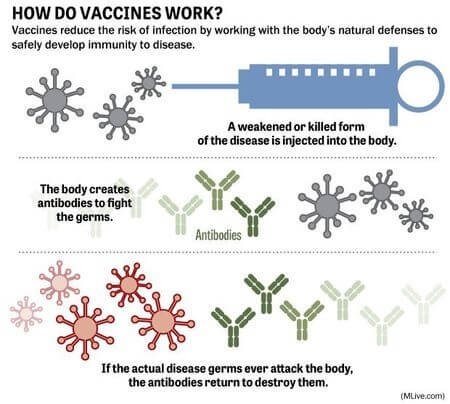
- Introduction of Antigens:
- Vaccines contain either weakened or inactivated forms of the pathogen (such as viruses or bacteria) or specific parts of the pathogen (like proteins).
- When we receive a vaccine, these antigens are introduced into our body.
- Immune System Activation:
- Our immune system recognizes these antigens as foreign invaders.
- Specialized cells, such as B cells and T cells, respond to the antigens.
- B Cell Response:
- B cells produce antibodies—proteins that specifically target the pathogen.
- These antibodies bind to the antigens, neutralizing them and preventing infection.
- Memory Cells Formation:
- Some B cells become memory B cells.
- These memory cells “remember” the pathogen and remain in our system for a long time.
- T Cell Response:
- T cells play a critical role in coordinating the immune response.
- They help B cells produce antibodies and directly attack infected cells.
Long-term Immune Protection
- Memory B Cells and Long-Lived Plasma Cells (LLPCs): Memory B cells and LLPCs are key players in long-term immune protection.
- They form after exposure to a pathogen (or a vaccine) and persist in our body for extended periods.
- Memory B Cells:
- Function: Memory B cells “remember” specific pathogens.
- Location: They reside in secondary lymphoid tissues (such as lymph nodes and spleen) and circulate in the blood.
- Response: When the same pathogen reappears, memory B cells quickly differentiate into plasma cells, producing specific antibodies.
- Durability: Memory B cells can persist for years or even decades.
- LLPCs:
- Function: LLPCs are antibody factories.
- Location: They primarily reside in the bone marrow.
- Response: When needed, LLPCs churn out antibodies against the pathogen.
- Durability: LLPCs can survive for a very long time—sometimes a lifetime.
|
Factors that contribute to the disparity in Vaccine Durability
Vaccine-Related Factors
Vaccine Type
- Live attenuated vaccines (e.g., measles, mumps, rubella):
- Mimic natural infection closely.
- Generate robust memory B cells and long-lived plasma cells (LLPCs).
- Provide long-lasting immunity.
- Inactivated vaccines (e.g., flu shots):
- May not induce LLPCs as effectively.
- Require periodic boosters.
Antigen Persistence
- Some vaccines maintain antigen presence longer (e.g., live vaccines).
- Prolonged antigen exposure enhances memory cell formation.
Adjuvants
- Adjuvants (like aluminium salts) enhance immune responses.
- They influence memory cell development.
Route of Administration
- Different routes (intramuscular, oral, nasal) impact immune memory.
- Intramuscular vaccines often generate robust responses.
Target Pathogen-Related Factors
- Pathogen Variation:
- Some pathogens mutate rapidly (e.g., influenza virus).
- Antigenic changes require frequent vaccine updates.
- Antigen Complexity:
- Complex pathogens (e.g., HIV) challenge vaccine design.
- Generating effective immune memory is difficult.
- Persistence of Pathogen:
- Some pathogens (e.g., hepatitis B virus) persist in the body.
- Vaccines must maintain immune memory over time.
Host-Related Factors
- Individual Variation:
- Genetics, age, health status influence responses.
- Some individuals mount stronger reactions than others.
- Immunosuppression:
- Immunosuppressed individuals (e.g., transplant recipients) may have weaker immune memory.
- Vaccination strategies must consider such populations.
Way Forward
- Develop vaccines that stimulate robust and durable responses.
- Tailor vaccines based on individual factors.
- Design effective booster schedules.
- Boost memory cell responses when needed.
- Address disparities in vaccine access and equity.
{GS3 – Envi – Conservation} Captive Elephant Rules, 2024
- Context (TH | TH): The Centre has notified Captive Elephant (Transfer or Transport) Rules, 2024, which liberalises the conditions under which elephants may be transferred within or between States.
What are the rules around the transfer and transport of elephants?
- According to the provisions of the Wildlife Protection Act, elephants are a Schedule 1 species and, therefore, cannot be captured or traded, whether wild or captive.
- Section 12 of the Act allows Schedule I animals to be translocated for ‘special purposes’ such as education and scientific research.
- They can also be translocated to manage wildlife populations without harming wild animals and to collect specimens for recognised zoos/museums.
- Captive elephants, because of their historical role in forest management, timber transport, presence in estates of erstwhile royal families, and in temple precincts for religious purposes, can be owned and, therefore, come under a special category. However, strict rules guide the transfer of such elephants.
- Section 40 (2) of the Wildlife Protection Act, 1972, prohibits the acquisition, possession, and transfer of a captive elephant without the written permission of the state’s Chief Wildlife Warden.
- Until 2021, however, these laws explicitly prohibited such transactions from being of a ‘commercial nature’.
- In 2021, the Environment Ministry introduced an amendment that allowed the transfer of elephants for ‘religious or any other purposes’.
What do the updated rules say?
- These rules provide new relaxations under which captive elephants can change owners or be transferred.
- These include, for instance, circumstances under which captive elephants can be transferred:
- When an owner is no longer in a position to maintain the elephant,
- The elephant will likely have better upkeep than in the present circumstances,
- When a state’s Chief Wildlife Warden “deems it fit and proper” in the circumstances of the case for better upkeep of the elephant.
- Before a transfer within the State, a veterinarian must ratify an elephant’s health, and the Deputy Conservator of Forests has to establish that the animal’s current and prospective habitats are suitable.
- The Chief Wildlife Warden may reject or approve the transfer upon receipt of such documents.
- If the transfer involves moving the elephant outside of a State, similar conditions apply.
- Before a transfer is affected, the elephant’s “genetic profile” must be registered with the Ministry of Environment, Forest and Climate Change.
- Earlier rules required that an elephant being transferred from, say, Assam to Gujarat get permission from the Chief Wildlife Wardens of every State it passes through while being ferried by road.
- Now, only the originating and recipient States’ permissions are required.
{GS3 – S&T – Defence} High-Altitude Platform System (HAPS)
- Context (EAT): Indian company Veda Aeronautics teamed up with UAE-based Mira Aerospace to make an India-specific High-Altitude Platform System (HAPS) or pseudo satellite.
- Through this collaboration, Mira Aerospace will share its advanced ApusNeo HAPS technology with India, and VEDA Aeronautics will contribute its local development expertise.
- The partnership will expedite the acquisition of this technology for India.
- The product will serve both Indian Defense and civilian customers.
- Test flights have already been conducted in Indian airspace, marking a significant milestone.
- VEDA Aeronautics will develop the HAPS as part of the Make-1 project funded by the Indian Air Force (IAF).
- The HAPS will carry at least a 35-kilogram payload and operate at 18,000 meters altitude for 30-45 days.
|
Significance
- The technology is crucial for future air combat, utilising solar energy for day travel and solar-charged batteries for night flight.
- These platforms are lightweight, remotely controllable, and equipped with communication capabilities beyond the line of sight.
- HAPS can handle a significant portion of a satellite’s workload at a lower cost and with longer viability.
- Compared to high-cost HALE drones like the Reaper, pseudo satellites drastically reduce surveillance expenses, costing less than $500 per hour to operate.
- The HAPS system will be crucial for India’s drone wingman project, which plans to conduct its maiden flight in 2024.
- India needs more ISR and communication data capabilities, which HAPS can provide.
To know more on HAPS, visit > High-Altitude Platform System (HAPS)
{GS3 – S&T – ISRO} IAU recognises ‘Statio Shiv Shakti’ point
- Context (HT | TH): The International Astronomical Union (IAU) Working Group for Planetary System Nomenclature approved the name ‘Statio Shiv Shakti’ for the landing site of Chandrayaan’s Vikram lander.
- On August 26, the PM announced that the landing site of Chandrayaan 3’s moon lander would be named Shiv Shakti.
- The naming choice draws from Hindu mythology, where the term “Shivshakti” finds its roots.
- Explaining the selection of “Shivshakti” as the touchdown point’s name, PM highlighted the inherent connection between humanitarian determination and the concept of Shiva. He pointed out that from Shakti arises the capability to actualise these humanitarian ambitions.
- The “Shakti” component within “Shiv Shakti” is a tribute to the diligence, inspiration, and empowerment of women scientists.
Learn more about > Naming Landing Sites on Moon & Chandrayaan 3 Mission.
{Prelims – In News} Shaheed Diwas
- Context (IE): Shaheed Diwas observed on March 23, commemorates the death anniversary of 3 Indian revolutionaries: Bhagat Singh, Sukhdev Thapar, and S. Rajguru.
- On this day in 1931, they were hanged to death in Lahore’s Central Jail for the murder of British police officer John Saunders.
Bhagat Singh
- An Indian anti-colonial revolutionary who played a significant role in India’s struggle for independence.
- Bhagat Singh was born on September 28, 1907, in Banga, Punjab (British India).
- His father was Kishen Singh Sandhu, and his mother was Vidyavati.
- Bhagat Singh was deeply influenced by the Jallianwala Bagh massacre and the freedom struggle.
- He joined the Hindustan Socialist Republican Association (HSRA) and became a vocal critic of British rule.
Learn more about Bhagath Singh >PMF IAS CA Septrmber 29, 2023
Sukhdev Thapar
- Born on May 15, 1907, in Ludhiana, Punjab, British India (now part of Punjab, India).
- Belonged to a Punjabi Khatri family and was raised by his uncle after his father’s death.
- Revolutionary Activities:
- Member of the Hindustan Socialist Republican Association (HSRA) and the Naujawan Bharat Sabha.
- Instrumental in revolutionary movements in Punjab and northern India.
- Participated in a prison hunger strike in 1929.
- Notably involved in the Lahore Conspiracy Case (1929–1930).
- Played a key role in the assassination of Assistant Superintendent of Police J. P. Saunders on December 17, 1928, as retaliation for the death of senior leader Lala Lajpat Rai.
Shivaram Rajguru
- Born on August 24, 1908, in Khed (near Pune), Maharashtra.
- Hailed from a Marathi Deshastha Brahmin family.
- Revolutionary Activities:
- Active member of the Hindustan Socialist Republican Association (HSRA).
- Participated in the assassination of British police officer John Saunders in Lahore.
Legacy
- His birthplace, Khed, was renamed Rajgurunagar in his honor.
- Rajguru Wada (his ancestral house) is maintained as a memorial.
{Prelims – PIN India} Moyar Valley
- Context (IE): Moyar Valley stands out as an exceptional breeding ground for Gyps vultures in southern India.
- Unlike other states in the region, Tamil Nadu hosts a thriving population of these majestic birds.
Moyar Valley
- The Moyar Valley stretches approximately 85 km from Gudalur through the core area of the Mudumalai Tiger Reserve within the Nilgiri Biosphere Reserve in Tamil Nadu.
- It weaves through a picturesque landscape of hills and deep gorges, creating a rich and diverse habitat.
- This valley serves as a wildlife haven, sheltering several vital species: Tigers, Elephants, gaurs, ungulates like spotted deer, blackbuck, sambar and the critically endangered Gyps vulture.
- It is the only region in peninsular India where the largest nesting colony of Gyps vultures can be found in the wild.
- Carcasses of wildlife from Moyar village to Bhavanisagar serve as a vital food source for vultures.
- These carcasses are mostly free from harmful substances like NSAIDs (non-steroidal anti-inflammatory drugs) and other poisonous chemicals.
Gyps Vultures
Ecological Significance
|
{Prelims – S&T – Space} Shakti & Shiva: Milky Way’s earliest building blocks
- Context (HT | IE): Astronomers have identified two ancient streams of stars named after ‘Shakti’ and ‘Shiva’, believed to be among the Milky Way Galaxy‘s earliest building blocks.
- Both ‘Shakti’ and ‘Shiva’ were found using observations from the European Space Agency’s Gaia space telescope.
- According to astronomers, they might be relics of two distinct galaxies that merged roughly 12 billion years ago with the Milky Way’s primordial pieces during the galaxy’s infancy.
- ‘Shakti’ and Shiva’ are comprised of stars with similar chemical compositions that formed 12-13 billion years ago.
- Each of the structures has a mass about 10 million times greater than our sun.




![PMF IAS Environment for UPSC 2022-23 [paperback] PMF IAS [Nov 30, 2021]…](https://pmfias.b-cdn.net/wp-content/uploads/2024/04/pmfiasenvironmentforupsc2022-23paperbackpmfiasnov302021.jpg)

